100 Stories
Hiroshima Airport: Flying is Half the Battle
In spite of Hiroshima being a principal city in the Chugoku Region and boasting a population that exceeds 1.1 million people, I still cannot call it a big city. Instead, I would dub it “the largest medium-sized city in Japan” for a number of reasons. For starters, while our streetcar network may be extensive, the closest thing we have to a subway is four stations on the Astram Line, a simplistic and linear mass transit railway that runs mostly above street level. Additionally, we have a rather humble international airport located outside the city limits, so we don’t get as many international tourists flying into Hiroshima as we could. With that being said, though, airports and their surrounding areas often sport a couple tourist sites worth checking out, and Hiroshima Airport (hereinafter referred to by its IATA airport code “HIJ”) is no exception. As domestic flights to HIJ from Haneda or Narita Airports could potentially be more cost-effective than a one-way Shinkansen ticket (assuming you don’t have a JR Pass), I advise tourists to look into flying into and/or out of HIJ and to check out the sites in the vicinity, if time permits.
HIJ’s Facilities
HIJ is actually not located in Hiroshima per se, but rather an easterly city in the prefecture called Mihara. Even so, HIJ is still a fair distance away from central Mihara and doesn’t have a dedicated train station, so the only avenues of access are by car and bus. From the Hiroshima Bus Center, one can take the Airport Limousine Bus from platform 3, which takes about 55 minutes to reach HIJ and drops passengers on an island across from the airport building. From here, one can either ascend the escalator and cross the skybridge in the departure lobby, or cross the street and enter at street level into the arrival lobby. I usually take the escalator, but this time I opted to start my exploration of HIJ from the bottom up.

The first floor is what tourists see right after touching down at HIJ and coming out of the baggage claim. They have a tourist information center, rental car services, vending machines for bus tickets, a Family Mart, and a cafeteria-style restaurant. There are a couple of racks filled with brochures and flyers advertising a slew of places to visit and things to see all over Hiroshima Prefecture, and even a local such as myself can benefit from one of these guides, which can inspire me to take even more trips than I already do. I had no further business here, so I took the escalator to the second floor, where passengers check in for their domestic and international flights.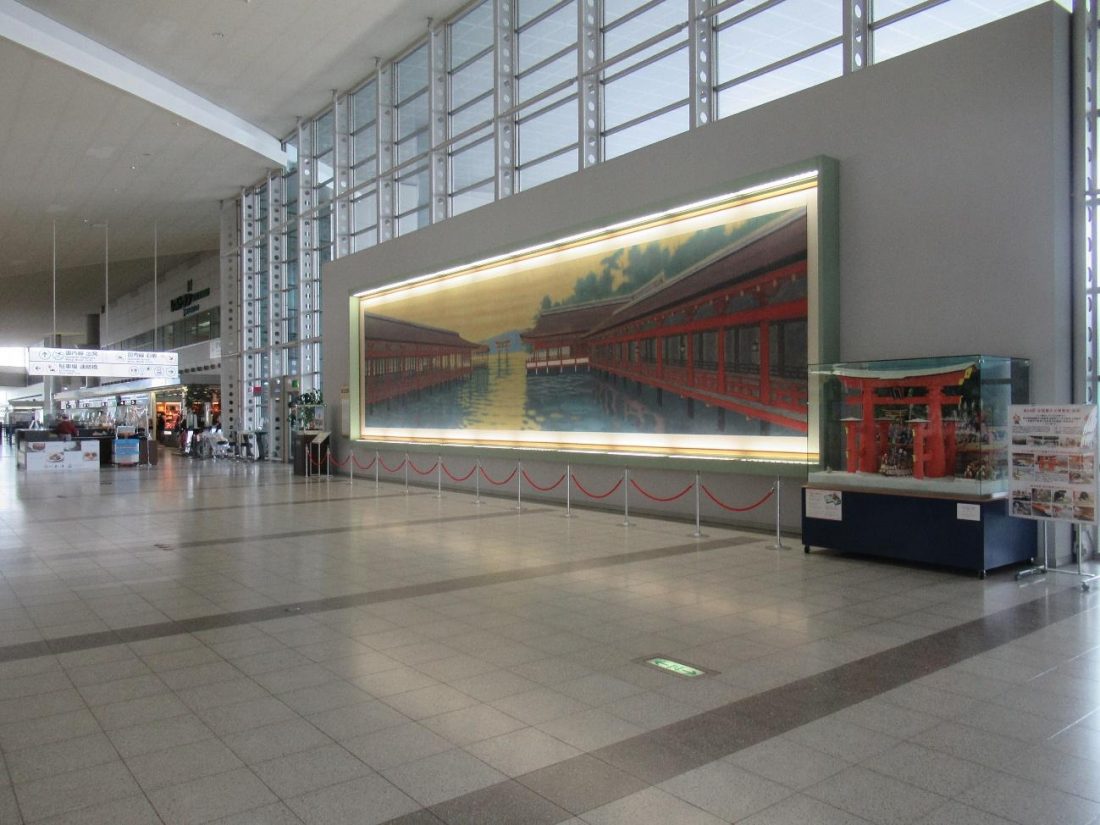
The second floor also features cafés, confection stands, along with stores selling books, Hiroshima souvenirs, and even leather goods. There’s also a wide, open space with an Itsukushima Shrine backdrop, reserved for limited-time pop-up events. Sometimes, it’s occupied by a stand selling regional foods, and at other times, animatronic dinosaurs steal the spotlight! On the other side, past the JAL check-in counters, they have two flight simulator pods next to some informative displays about airplane engines and other aviation trivia. Insert a coin and live out your dreams of being an airline pilot without flight experience, instrument training, or any sense of danger whatsoever!
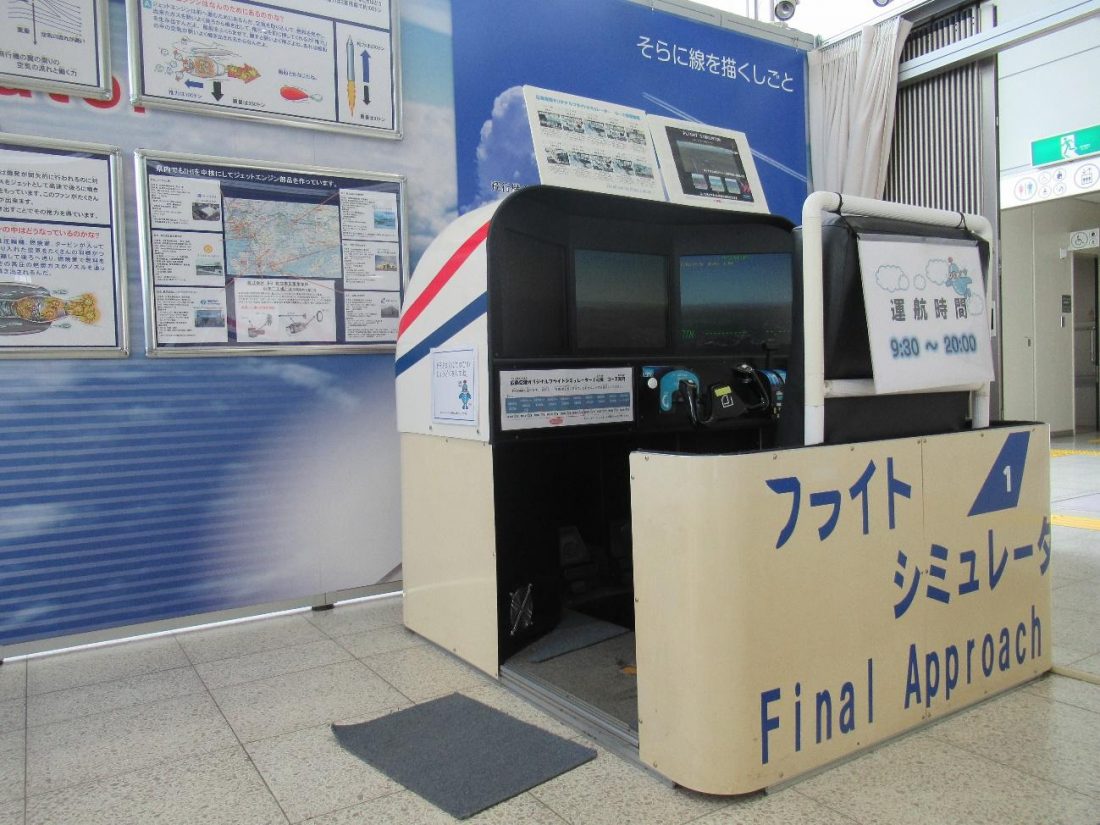
The third floor is home to an array of restaurants—some of which afford views of the runway—as well as a free observation deck. HIJ’s eateries serve a varied selection of cuisines, ranging from Goemon’s signature okonomiyaki and yakisoba to Royal Host’s cherished steaks and onion gratin soup. Goemon, ramen joint Yu, and another famous okonomiyaki chain Mitchan are lined up side-by-side in a dedicated food court area, but also let guests dine inside where they can be closer to the food being prepared for them. Today’s feeling like a Hiroshima ramen kind of day, so I’ll circle back once I’m done checking out the observation deck.

Moment of Joy: Lunch and a Show
I stepped outside to find several families at the fence, facing two aircraft about to depart. HIJ’s observation deck is pretty long, with seating areas and larger rectangular holes in the fence for people to stick out their cameras. There was an air of suspense as we all eagerly waited for ANA Flight 678 to take off, and what a sight it was when it did! I was so amazed by the spectacle that I came back here in the middle of my lunch just to see it again.
Knead for Feed
After checking out the observation deck, I returned inside to a bowl of piping hot Hiroshima-style ramen, which I ate at the counter. This one had spicy broth—of which only ten batches per day are made—and I also ordered a larger portion of noodles for good measure. Inside the privacy of the store, I was able to enjoy it slowly in solitude, and the shop attendant had no qualms with me leaving in the middle of my meal to watch another plane take off. When I returned, I wolfed down the rest of the bowl and left HIJ.

I exited out the arrival lobby—the same way I came in—and turned right, following the signs to Sankeien, a landscape garden right beside the Hiroshima Airport Hotel. Don’t let your map apps fool you; from HIJ, there’s only one way to access the garden since cutting through the parking lot is not permitted, so just follow the arrows and you’ll be fine. Sankeien was built in 1993 to commemorate the opening of HIJ, but it’s definitely a tourist attraction in its own right that’s worth visiting even if one has no business at HIJ. In addition to the seasonal flowers that bloom and wither throughout the year, Sankeien also hosts events that correspond to the contemporary flora and some traditional Japanese holidays, which warrants multiple visits. A ticket is good for the entire day, and re-entry is allowed, so I paid for admission at the counter and took a brief stroll around the gargantuan pond before proceeding to the next item on my agenda.
Back outside the entrance the Sankeien, I hung a right and walked around the outer edge of the garden to an intersection, then crossed the street and entered the parking lot at the base of Hattendo Village. Hattendo is a locally famous bakery (with a stand inside HIJ’s departure lobby) that has its factory and café on a hill overlooking the parking where I was. Besides those two buildings, Hattendo Village also features a day care center, a playground, a pony farm, and picnic spaces with food stands and other establishments nearby. Today, however, I’ll only be visiting the building on the right to participate in a unique bread-making workshop.
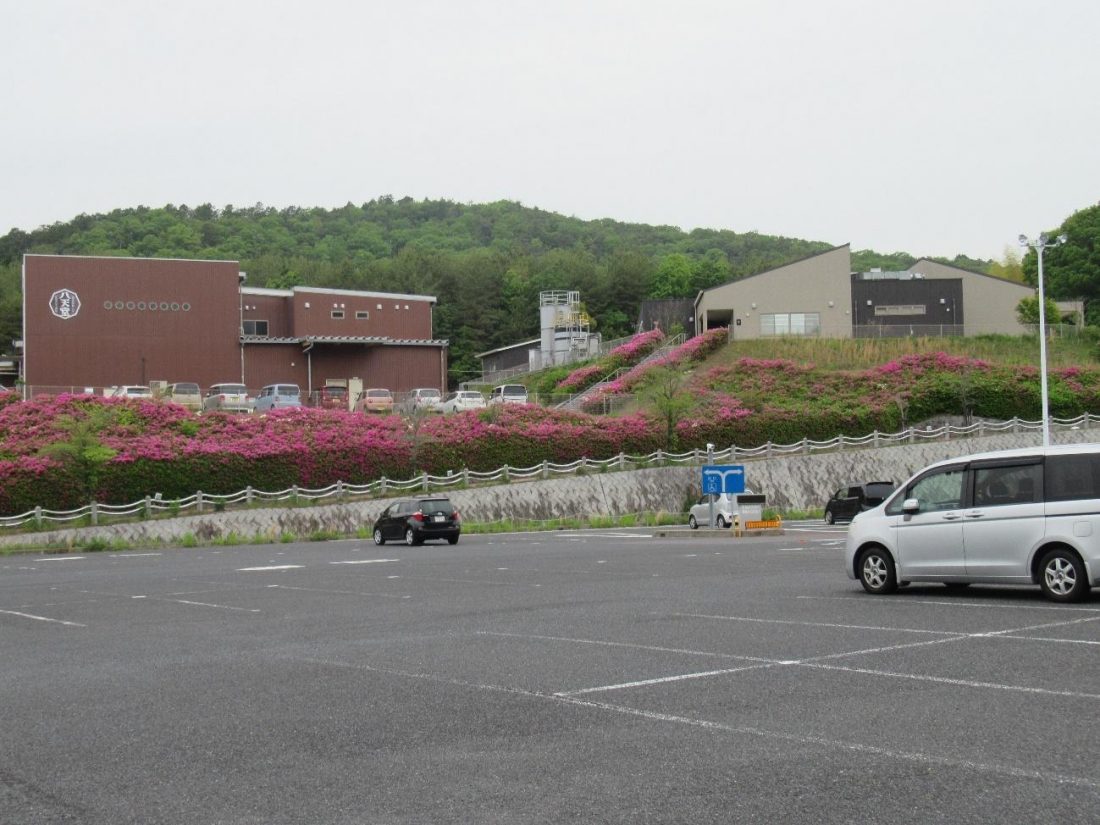
When I entered the workshop, I confirmed my reservation (done online, in Japanese) and found that everything I needed to craft my baked goods was already neatly arranged on a table. Hattendo provided me with two different kinds of dough, a chocolate icing pen, a cup of pizza sauce, a plastic spoon for scooping and spreading, shredded cheese, corn, spam cut into cubes, a rolling pin, and some flour used to coat the dough so it doesn’t stick to the table. Before touching anything, we first listened to our instructor explain and demonstrate how to knead dough. If you don’t understand Japanese, fret not; there are cartoons on a big whiteboard illustrating the three steps. After hearing the instructions, we got right to it, starting with the dough ball on the left, used to make our sweet bread.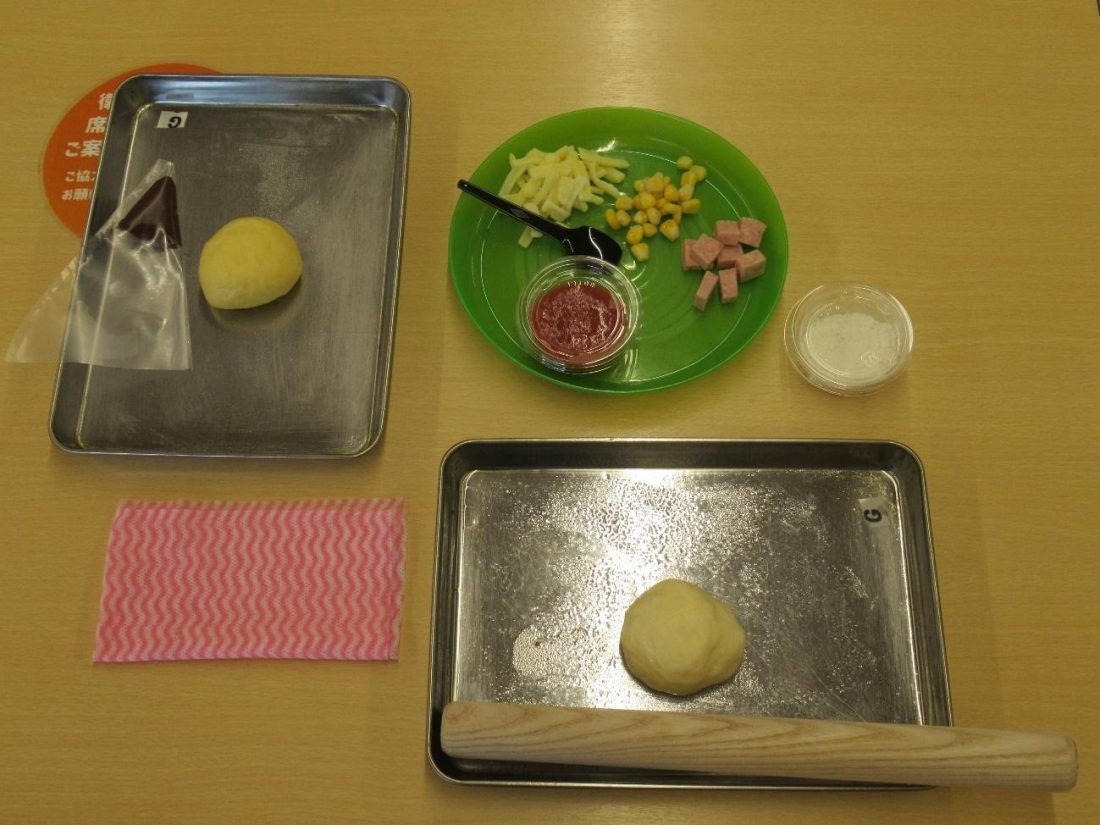
The first step in kneading the dough is to press down on it with the side of one’s hand, using a karate chop-like motion to cut pieces off of the dough. Second, bend the fingers and thumb of one hand to make a “cat paw” and roll the pieces into smaller balls. The third phase involves sticking the little dough balls back together, which is easier done if one end of each ball is stretched out just a little bit. Be sure to keep in mind the shape of your desired product; for instance, since I wanted to make a flower shape, I cut off five small balls to be turned into petals. Finally, use the chocolate icing pen to draw a design onto the bread and hand it to the instructor, who will bake it in the back kitchen. My chocolate icing flower bun turned out like this!
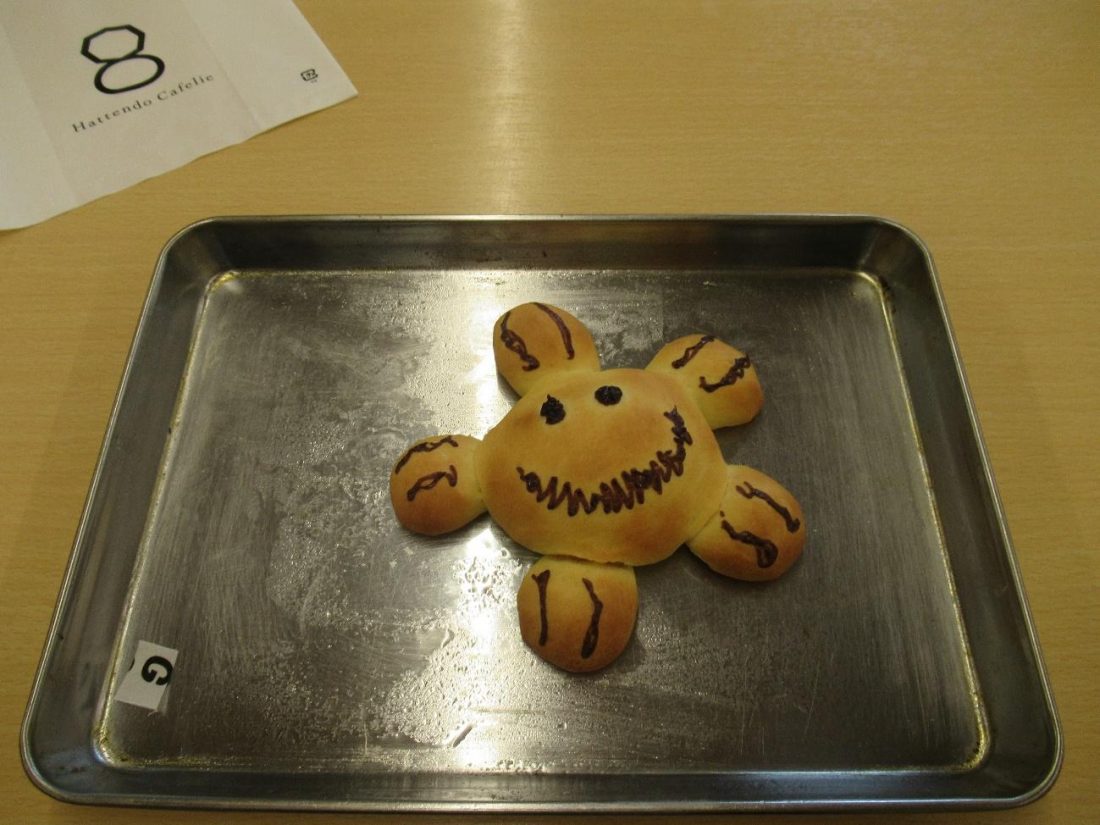
While this little guy was baking, we got started on the mini pizza. I covered the second dough ball in flour and used the rolling pin to turn it into a disc. After that, I pinched the edges of the crust, piled on the sauce, cheese, and corn, and then made a smiley face with the spam cubes. The instructor handed me my chocolate flower bun as she took up my pizza for baking, and from then we commenced the final phase of the workshop: wrapper design. I picked up a basket of colored markers along with two blank wrappers and got to coloring. By the time I finished drawing on both wrappers, my pizza came out of the oven, piping hot with gooey cheese, its smile a reflection of my pride in my culinary prowess.
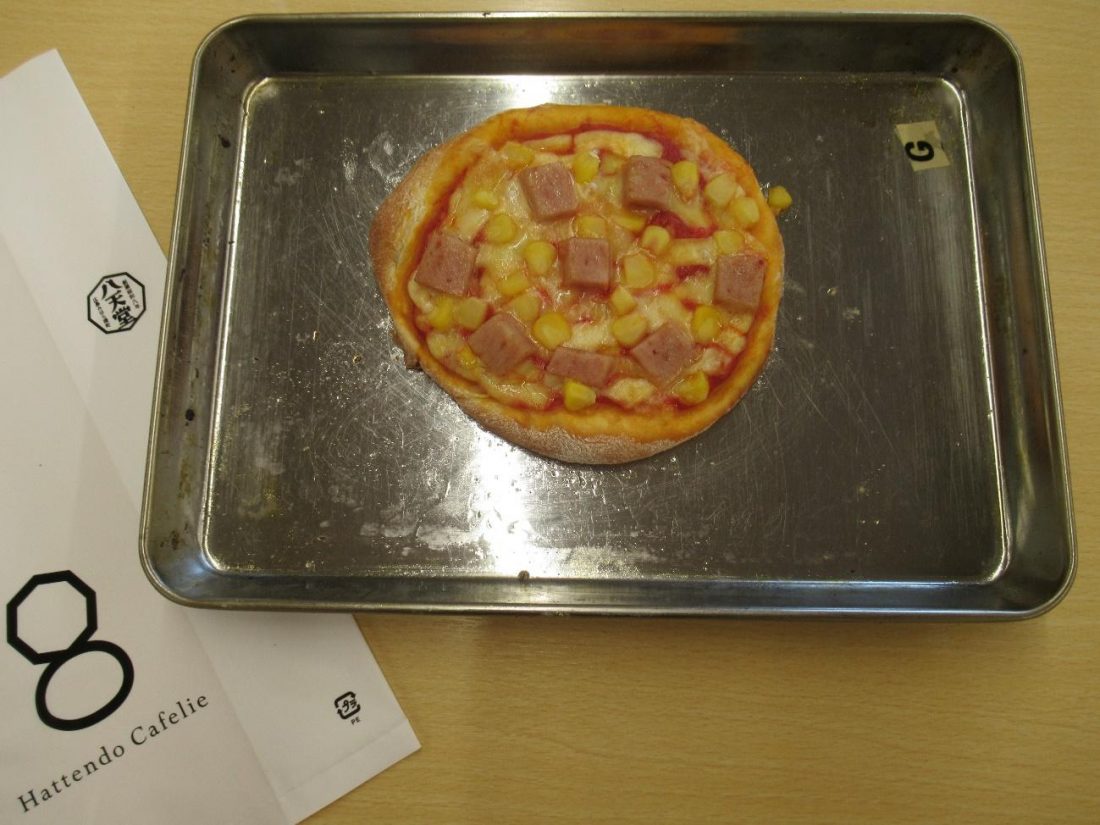
Shortly after the pizza cooled down, I put both of my baked goods into my crudely colored wrappers, taped them shut, and placed them into a plastic bag to save for later. Guests can also eat their creations on the spot, but my belly was still full from spicy ramen and I’d rather eat these in the great outdoors anyway. Upon leaving the workshop, I took one long, last look at the various baked items for sale in the café before making my way back to Sankeien.
Three Scenes
I returned to the front entrance of Sankeien, flashing my ticket to enter again. The name Sankeien in Japanese (三景園) translates to “three scene garden,” an apt moniker for what I saw in this garden today as there were indeed many views to be relished at Sankeien that I would roughly divide into three categories: botanic, aquatic, and aeronautic. The first scene visitors will encounter after going past the front door will most likely be the aquatic component. Simply look down into the water and you’ll be greeted by some ravenous carp gazing up at you, hoping you bought a bag of feed for sale at the gift shop. I didn’t need to buy any fish food to catch their shenanigans; watching others feed the carp was enough entertainment for me. Wherever in the pond the food is thrown is where all the fish in the vicinity reconvene, and flinging pellets in multiple areas results in a pluricentric piscine pig-out!
The next aspect that draws visitors’ attention will probably be the botanical element, and Sankeien certainly doesn’t hold back with its lush greenery and floral diversity. There are dedicated zones for select flowers like irises, peonies, and hydrangeas, but as I visited in early May, I was late to catch the former two in their peak, so barely any were left. As for the hydrangeas, they don’t quite flourish until June, so while there were some, I couldn’t find enough to take any noteworthy photos. It’s a good thing green leaves are around most of the year, and they sure compliment the waterfalls well. Sights such as these can be found at key bridges and other vantage points throughout the walking trails at Sankeien.
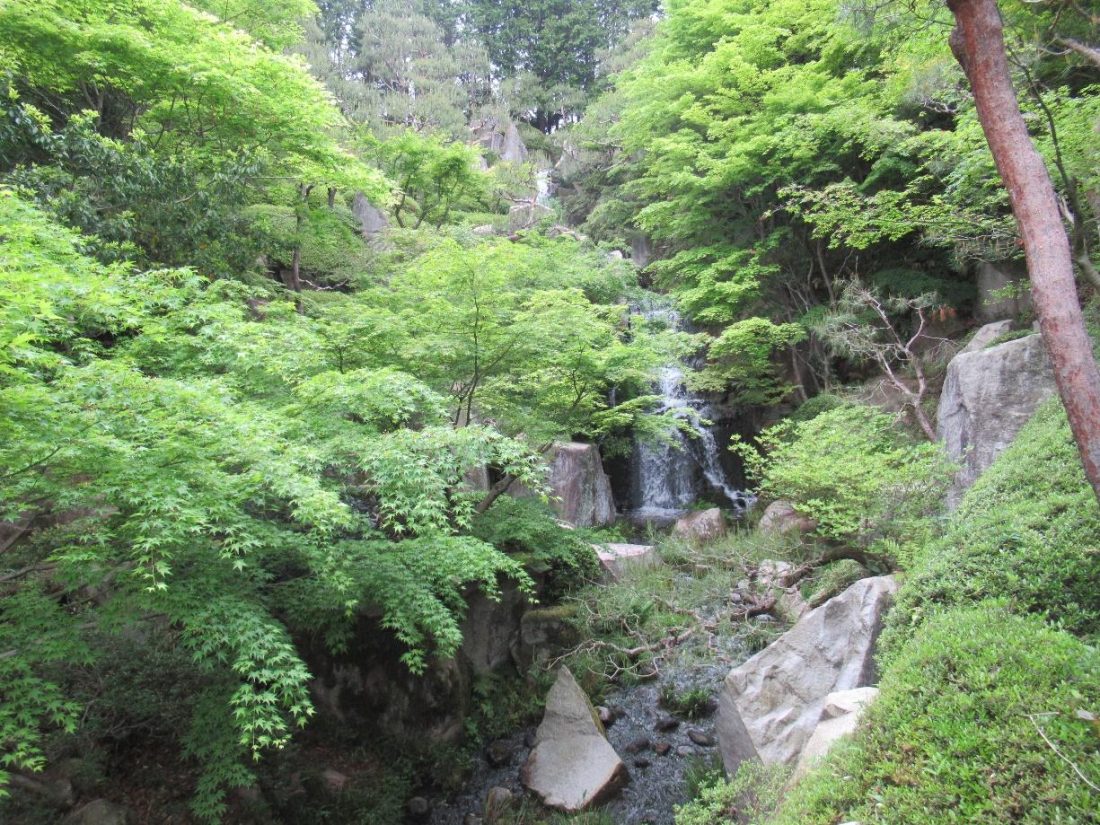
Outside the enormous central pond by the front door, Sankeien is dominated by a labyrinth of interconnected paths, some with slopes and others with stairs, to let the viewer appreciate the garden from a variety of angles and differing heights. Since I have the natural tendency to explore every nook and cranny of these gardens even when the paths loop back around, I spent the rest of the afternoon hiking up and down every road Sankeien offered. It was close to closing time when I stopped at Kangetsutei, a quaint tea house-like structure up on a hill, overlooking the rest of the garden and allowing me to see the final type of scenery: the aeronautic aspect. I had a visual of HIJ’s control tower and part of the terminal building, and if I had timed things right, I could’ve also caught a glimpse of an airplane taking off or landing. It was tempting to pop a squat inside Kangetsutei and start munching on my Hattendo delicacies while staring out at the water, land, and sky, but Sankeien forbids eating and drinking anywhere in the facility, so I decided to be a good citizen and wait for a better time.
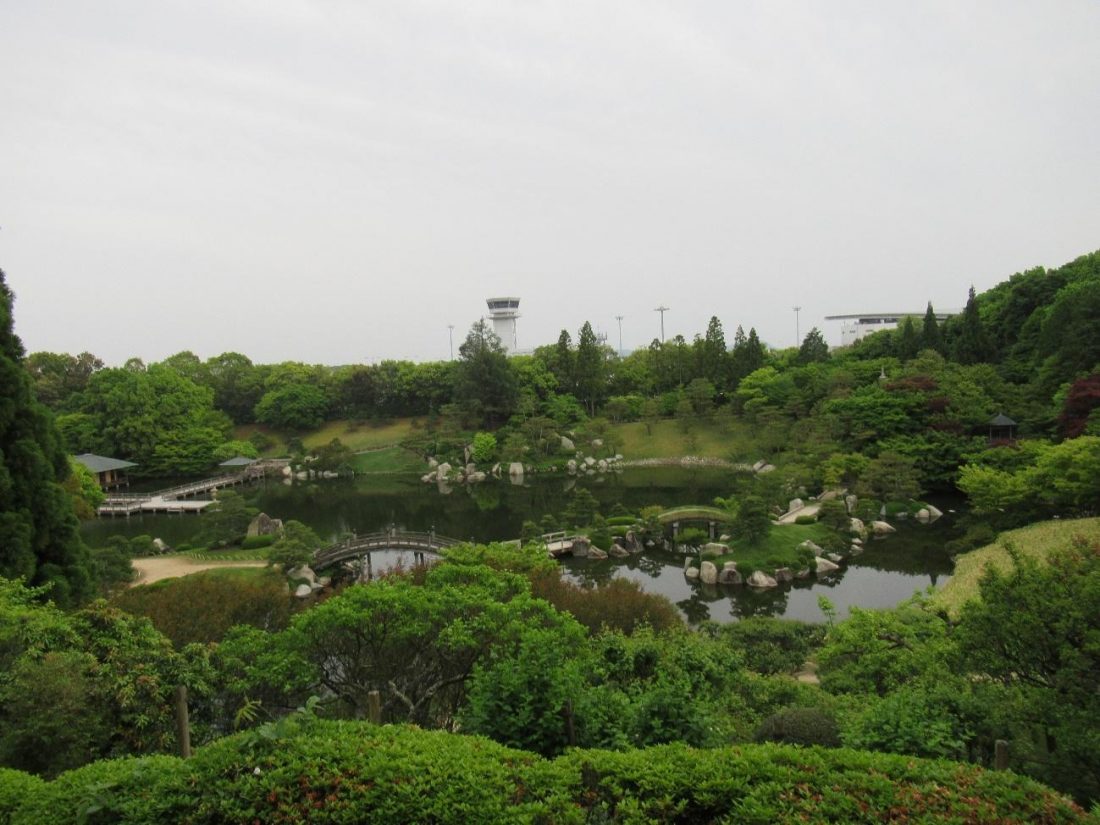
VIP: Viable Isolated Post
Despite leaving Sankeien before it closed at 6:00 p.m., I got to the front door to find it closed and locked. Maybe I was the only one to linger as long as I did and overstayed my welcome, but as I saw no one at the reception desk, I tried fiddling with the lock to open the sliding door on my own. It was to no avail, but a man inside the office saw my plight and came out to unlock the door and set me free. Business hours were over but the sky was still bright, so I chose to continue exploring the area behind the Hiroshima Airport Hotel. I just so happened to be getting hungry again at that, so I was also hoping I could find a place where I could sit and eat my baked goodies.
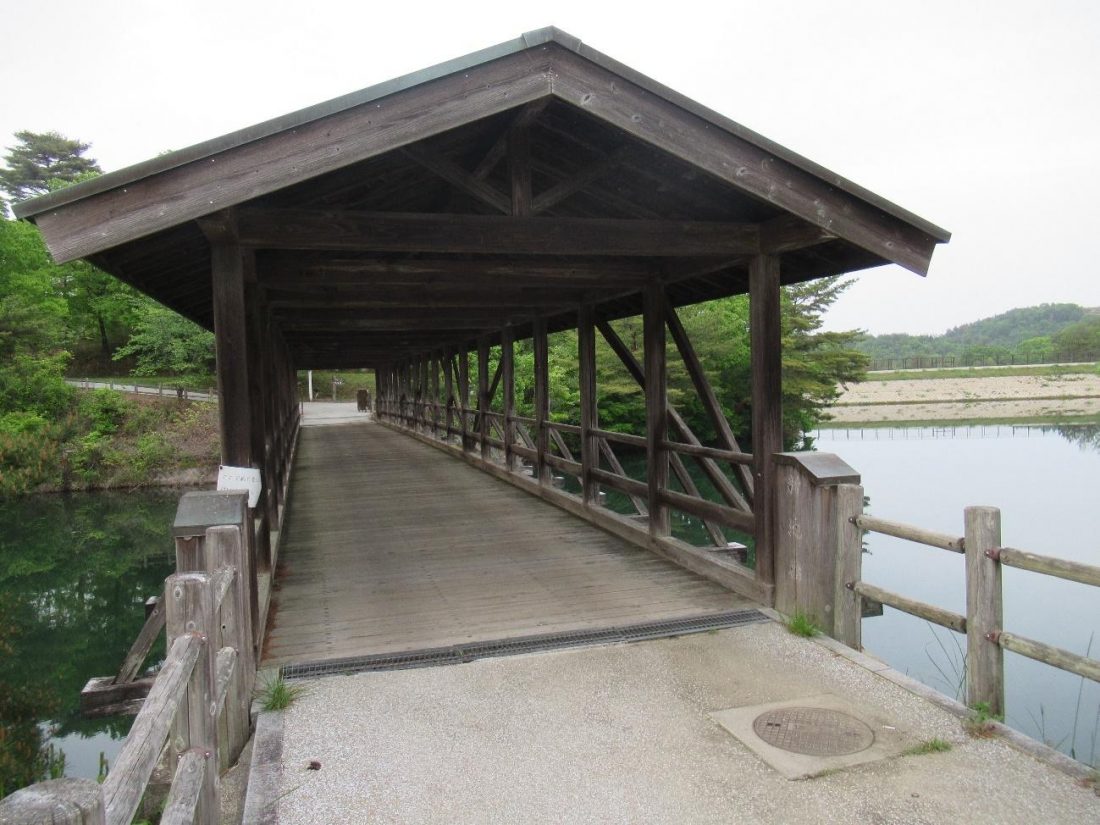
I began my expedition at this covered bridge that I could also see from within Sankeien. Naturally, as I walked across the bridge and looked to my left, I could see a section of Sankeien across the water, which was still and whose surface shone like a mirror. After crossing over, I turned right and hugged the edge of the reservoir as I trekked on. The trail took me over a small dam, past a public restroom, and by a spacious grassy area before delving into the forest. During this time, I could hear the deafening roar of an engine, letting me know I was fast approaching HIJ. I eventually came out of that opening on the right and ended up in some kind of hilly sanctuary that commanded a prime view of HIJ’s runway.
There were benches up on this hill, so I plopped down and scarfed down my pizza and flower bun, hoping to catch the next departure out of HIJ. A few minutes later, lo and behold, ANA Flight 684 enters my field of vision! I made my way up to the fence as the engines whirred, and made sure to capture the vessel on camera as it took to the skies. Combined with the radiant sunset this time of day, this seemingly hidden alcove ended my adventure on a high note, and my wish is for more people to come across this lookout point to see these planes up close in a way few others can.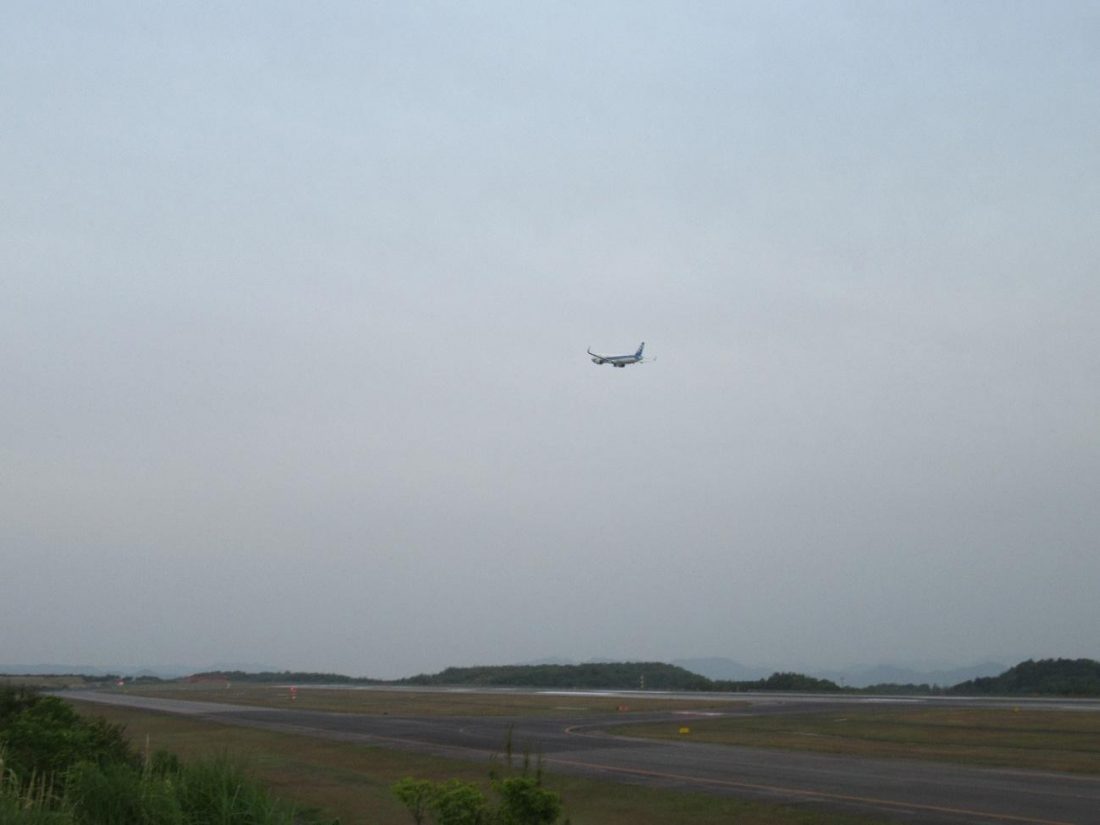
Airports themselves are destinations, and those who visit HIJ just to fly are missing out on a whole lot. I myself had been living in Hiroshima for over six years before I finally decided to see what the surroundings are all about, and today’s journey only made me regret not coming here sooner. If you get the chance to use HIJ at any point during your Japan trip, I highly recommend making a day trip out of this locale, either on the first day when you arrive before taking the bus into town, or on the last day before your scheduled departure. Even small cities like Mihara can house a stash of tourist sites right under people’s noses, and promoting these little-known places may be the key to helping Hiroshima’s popularity grow. Those who were previously unaware of HIJ and its appeal now know several reasons to drop by, and knowing is half the battle.




